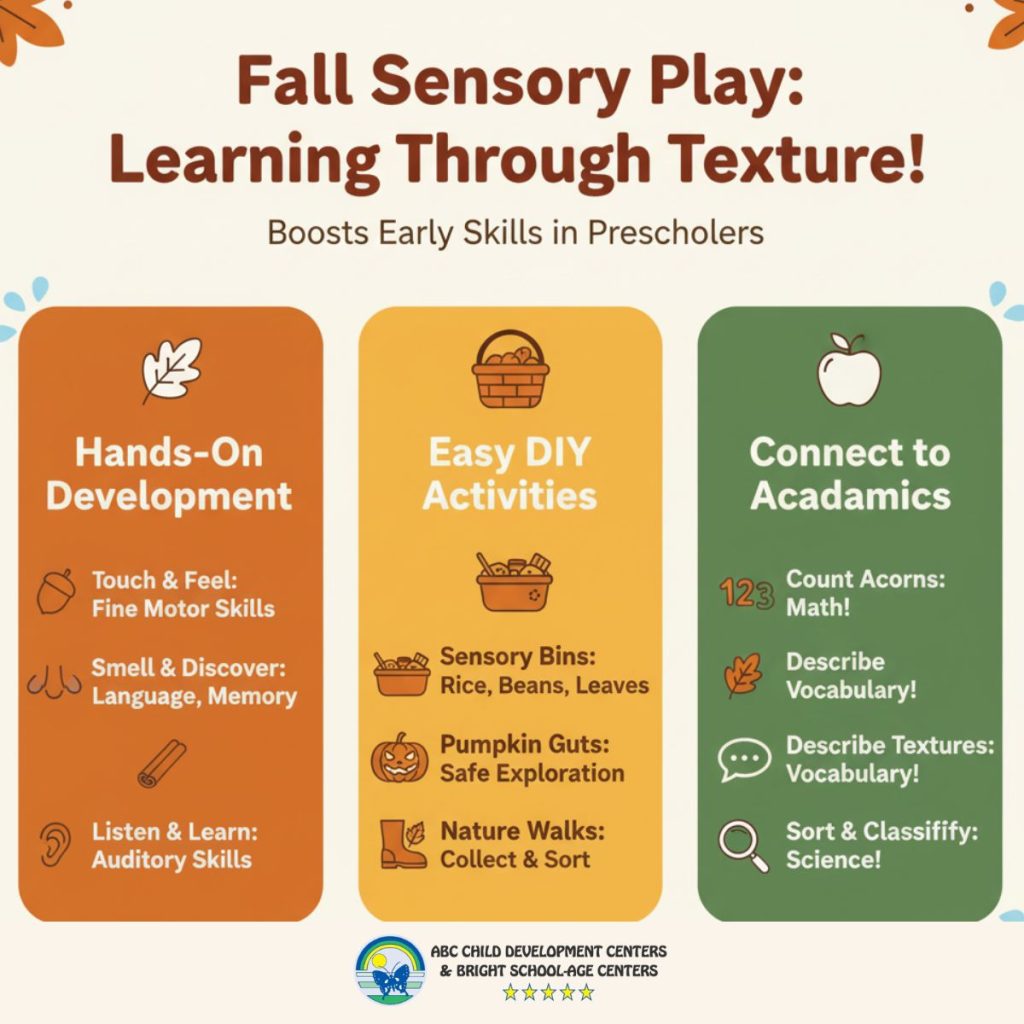The crisp air and vibrant colors of fall aren’t just beautiful; they are a goldmine for your child’s brain development! In this post, we’ll dive into sensory play using seasonal materials, explaining how these experiences build critical neural pathways, and share expert tips for creating safe, enriching activities at home and finding the best preschool in Greeley that embraces this philosophy.
Why Sensory Input is Essential for Preschoolers

Sensory play involves any activity that stimulates your child’s five senses: sight, smell, touch, taste, and hearing. For toddlers and preschoolers, this type of hands-on exploration is how they process information, develop language, and organize the world around them. According to Zero to Three, this exploration strengthens nerve connections in the brain’s pathways, laying the groundwork for complex learning.
At ABC Central, our play-based curriculum is designed to intentionally incorporate diverse sensory experiences every day.
Types of Sensory Input We Tap Into This Fall
We don’t just see a pumpkin; we explore it with all our senses! Here is a breakdown of how common fall elements engage your child’s development:
- Tactile (Touch): Feeling the smooth, cool skin of a pumpkin vs. the jagged, crunchy texture of fall leaves helps children classify objects and build fine motor skills.
- Olfactory (Smell): Introducing natural scents like cinnamon sticks, cloves, or the damp earth after a rain deepens memory formation and provides a rich vocabulary for descriptive language.
- Auditory (Sound): Listening to the crunch of dry leaves underfoot, the rattle of dry corn kernels, or the gentle ‘tink’ of acorns being dropped into a bucket enhances listening skills and auditory processing.
Integrating Sensory Play with Academics
Sensory activities are not just a way to keep children busy, they are a vehicle for teaching foundational academic concepts. This is how learning through play Greeley works in practice at a quality center.
Sensory Play Meets Core Subjects:
| Academic Area | Fall Sensory Activity | Skill Developed |
| Math | Counting Acorns: Use tongs to pick up and count acorns or dry beans into small cups. | One-to-one correspondence, number recognition, fine motor skills (pincer grasp). |
| Language Arts | “The Pumpkin Feels…” Use descriptive words (e.g., bumpy, cold, rough, round) while exploring a pumpkin. | Vocabulary expansion, expressive language, adjectives. |
| Science | Leaf Sorting: Collect and sort leaves by size, color, or type. | Classification, observation, hypothesis testing, understanding of the environment. |
Pro Tips: DIY Fall Sensory Bins & Safety at Home
You can easily replicate this high-value learning at home. Sensory bins are contained spaces (like a plastic storage tub) filled with materials for scooping, digging, and pouring.
Step-by-Step DIY Fall Sensory Bin:
- Choose a Base: Use dried corn kernels, brown rice (dyed with food coloring), or dry beans.
- Add Tools: Include scoops, small cups, tongs, and funnels.
- Introduce Fall Textures: Mix in small, natural items like acorns, small pinecones, or cinnamon sticks.
- Enrichment: Hide small plastic toy animals (like squirrels or bears) for imaginative play.
Common Mistake: What to Avoid
It’s crucial that parents using child care programs in Greeley understand safety when creating sensory activities for young children.
- What to Avoid: Do not use small, whole nuts (like peanuts or almonds), or pieces of hard candy that resemble their favorite treats. For children under three, ensure all small pieces (like acorns or very small pinecones) are non-toxic and large enough not to be a choking hazard; or, better yet, use large, non-edible materials like dried gourds and corn cobs.
- Top Tip: Always supervise children during sensory play, especially when edible materials are used, and set clear rules that the items must stay in the bin.
Investing in Play is Investing in Potential
Sensory play is a foundational pillar of early education because it respects the natural way a child’s brain learns. By providing these rich, hands-on opportunities, we are not just occupying their time; we are actively teaching them to be problem-solvers, communicators, and critical thinkers.
If you are searching for child care programs in Greeley that prioritize a robust, evidence-based curriculum, we invite you to see our approach to learning through play Greeley firsthand.
Contact ABC Central Child Development Center to schedule a tour and enroll your child today!
